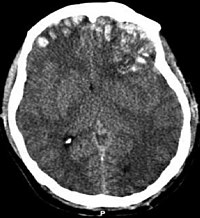
Photo from wikipedia
Traumatic brain injury (TBI) is a major public health issue, with recently increased awareness of the potential long‐term sequelae of repetitive injury. Although TBI is common, objective diagnostic tools with… Click to show full abstract
Traumatic brain injury (TBI) is a major public health issue, with recently increased awareness of the potential long‐term sequelae of repetitive injury. Although TBI is common, objective diagnostic tools with sound neurobiological predictors of outcome are lacking. Indeed, such tools could help to identify those at risk for more severe outcomes after repetitive injury and improve understanding of biological underpinnings to provide important mechanistic insights. We tested the hypothesis that acute and subacute pathological injury, including the microgliosis that results from repeated mild closed head injury (rmCHI), is reflected in susceptibility‐weighted magnetic resonance imaging and diffusion‐tensor imaging microstructural abnormalities. Using a combination of high‐resolution magnetic resonance imaging, stereology, and quantitative PCR, we studied the pathophysiology of male mice that sustained seven consecutive mild traumatic brain injuries over 9 days in acute (24 hr) and subacute (1 week) time periods. rmCHI induced focal cortical microhemorrhages and impaired axial diffusivity at 1 week postinjury. These microstructural abnormalities were associated with a significant increase in microglia. Notably, microgliosis was accompanied by a change in inflammatory microenvironment defined by robust spatiotemporal alterations in tumor necrosis factor‐α receptor mRNA. Together these data contribute novel insight into the fundamental biological processes associated with repeated mild brain injury concomitant with subacute imaging abnormalities in a clinically relevant animal model of repeated mild TBI. These findings suggest new diagnostic techniques that can be used as biomarkers to guide the use of future protective or reparative interventions. © 2016 Wiley Periodicals, Inc.
Journal Title: Journal of Neuroscience Research
Year Published: 2017
Link to full text (if available)
Share on Social Media: Sign Up to like & get
recommendations!